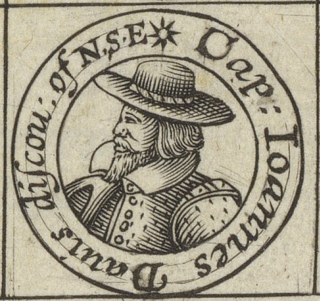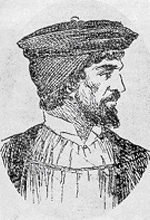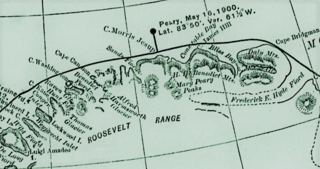
Gaspar Corte-Real (1450–1501) was a Portuguese explorer who, alongside his father João Vaz Corte-Real and brother Miguel, participated in various exploratory voyages sponsored by the Portuguese Crown. These voyages are said to have been some of the first to reach Newfoundland and possibly other parts of eastern Canada.

Portuguese colonization of the Americas constituted territories in the Americas belonging to the Kingdom of Portugal. Portugal was the leading country in the European exploration of the world in the 15th century. The Treaty of Tordesillas in 1494 divided the Earth outside Europe into Castilian and Portuguese global territorial hemispheres for exclusive conquest and colonization. Portugal colonized parts of South America, but also made some unsuccessful attempts to colonize North America.
William Baffin was an English navigator, explorer and cartographer. He is primarily known for his attempt to find a Northwest Passage from the Atlantic to the Pacific, during the course of which he was the first European to discover Baffin Bay situated between Canada and Greenland. He was also responsible for exceptional surveys of the Red Sea and Persian Gulf on behalf of the East India Company.

John Davis was one of the chief navigators of Queen Elizabeth I of England. He led several voyages to discover the Northwest Passage and served as pilot and captain on both Dutch and English voyages to the East Indies. He discovered the Falkland Islands in August 1592.

Didrik Pining was a German privateer, nobleman and governor of Iceland and Vardøhus.

The Cantino planisphere or Cantino world map is a manuscript Portuguese world map preserved at the Biblioteca Estense in Modena, Italy. It is named after Alberto Cantino, an agent for the Duke of Ferrara, who successfully smuggled it from Portugal to Italy in 1502. It measures 220 x 105 cm.

João Vaz Corte-Real was a Portuguese sailor, claimed by some accounts to have been an explorer of a land called Terra Nova do Bacalhau, speculated to possibly have been a part of North America. For his efforts, Corte-Real was offered the Donatário-Captaincies of São Jorge and Angra, respectively.
Miguel Corte-Real was a Portuguese explorer who charted about 600 miles of the coast of Labrador. In 1502, he disappeared while on an expedition and was believed to be lost at sea.

Gjøa was the first vessel to transit the Northwest Passage. With a crew of six, Roald Amundsen traversed the passage in a three-year journey, finishing in 1906.

Kolnopronounced[ˈkɔlnɔ] is a town in northeastern Poland, located in the Podlaskie Voivodeship, about 150 km northeast of Warsaw. It is the seat of Kolno County, and the seat of the smaller administrative district (gmina) called Gmina Kolno, but it is not part of this district, as the town has gmina status in its own right. Kolno has 10,730 inhabitants (2007).
David Melgueiro is alleged to have been a Portuguese navigator and explorer. He allegedly sailed across the Northeast Passage in 1660 by travelling from Japan to Portugal through the Arctic Ocean at a time when Portuguese vessels were banned from Japan. The story is considered to be a falsehood, with obvious factual errors in the account of the voyage and no historical evidence to support it or even confirm Melgueiro's existence.
SS Viking was a wooden-hulled sealing ship made famous by its role in the 1931 film The Viking. During her use in the seal hunt in Newfoundland, the ship was twice commissioned by the film crew. During production, an explosion destroyed the ship, resulting in the loss of the director, Varick Frissell, and the cinematographer, Alexander Gustavus Penrod, in addition to the lives of 26 of the ships' crew and film crew.
This is a chronology and timeline of the colonization of North America, with founding dates of selected European settlements. See also European colonization of the Americas.

Hans Pothorst was a privateer, likely from the German city Hildesheim.

John Cabot was an Italian navigator and explorer. His 1497 voyage to the coast of North America under the commission of Henry VII, King of England is the earliest known European exploration of coastal North America since the Norse visits to Vinland in the eleventh century. To mark the celebration of the 500th anniversary of Cabot's expedition, both the Canadian and British governments elected Cape Bonavista, Newfoundland as representing Cabot's first landing site. However, alternative locations have also been proposed.

Farthest North describes the most northerly latitude reached by explorers, before the first successful expedition to the North Pole rendered the expression obsolete. The Arctic polar regions are much more accessible than those of the Antarctic, as continental land masses extend to high latitudes and sea voyages to the regions are relatively short.
The exploration of North America by European sailors and geographers was an effort by major European powers to map and explore the continent with the goal of economic, religious and military expansion. The combative and rapid nature of this exploration is the result of a series of countering actions by neighboring European nations to ensure no single country had garnered enough wealth and power from the Americas to militarily tip the scales over on the European continent. It spanned the late 15th to early 17th centuries, and consisted primarily of expeditions funded by Spain, England, France, and Portugal. See also the European colonization of the Americas.
John Knight was a British explorer of Greenland and Labrador. He is known for two expeditions: he was a member of a Danish exploration of the coast of Greenland, and he led an expedition to discover the Northwest Passage, during which he was lost.

The Roosevelt Range or Roosevelt Mountains is a mountain range in Northern Greenland. Administratively this range is part of the Northeast Greenland National Park. Its highest peak is the highest point in Peary Land.












